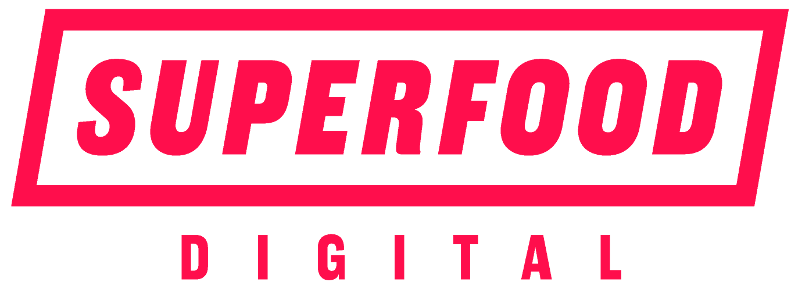Email marketing is a great way to get an effective return on investment – every $1 you spend on it results in $44 on average. However, it can be hard to grow your email list, especially as a food brand if most of your sales are in grocery stores.
One thing’s for sure: a generic email newsletter box in the footer of your website is not going to cut it!
But don’t worry, we’ve got you covered. In this article, we touch on 15 ideas you can use today to grow your email list so you can start marketing to a wider audience.
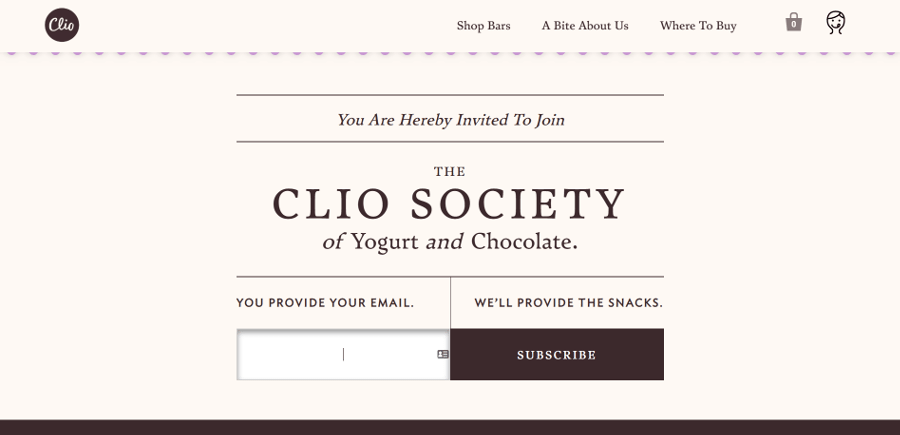
First, why is an email list even important for food brands if most sales are in store?
Email marketing is a fast way to communicate new product launches, promotions, store placements, and events to your audience. Email campaigns can encourage return visits to your website, remind browsers that abandoned carts, and deliver consistent value to your subscribers.
What are the benefits of email marketing over ads and other marketing activities?
A major benefit is that an email list is a marketing asset you completely own. You are not beholden to Google or Facebook for access. And it’s very cost-effective, almost free. In fact, you can even use your email list to retarget people on certain platforms for more effective and lower cost ad spend. Furthermore, email marketing provides a great way to segment subscribers based on what emails they open and click.
Now if you have an e-commerce store, you are probably collecting emails with each order. But there are still several ways to collect emails before a purchase or for customers that purchase in retail stores.
Below are some ideas to start growing the email list of your food brand today. We saved our favorite for last.
Let’s start with the basics:
1. Create an interesting blog so people actually want to sign up for your newsletter
No matter what food or beverage product is, you can always find something to blog about. Think about what problems you can solve, what questions you can answer, or what lifestyle issues you can talk about in your blog content.
Now, blogging alone will not grow your email list, but it will serve as a good way to ask readers to sign up for your newsletter or a free download (more on that later). If you’re not creating content people want to read and find useful, there’s no chance they will sign up for your newsletter. So high-quality, unique, and relevant blog content is the key.
One recommendation is to not only write about your brand. If you make protein bars for people who are outdoorsy and on-the-go, you could write blog content about the best hiking trails, camping hidden gems, or the best new bikes out this year. If you make oat milk, you can post recipes like smoothies, baked goods, and overnight oats. If you sell meat or vegetables, you can write blogs about safe storing and preparing, best methods for cooking, or how long your products can be stored in the fridge or the freezer.
You can really open up possibilities by writing about certain lifestyles. CLIF Bar’s blog features stories about people getting outdoors and engaging in healthy activities, but each post is a story, profiling people who are on a different type of adventure.
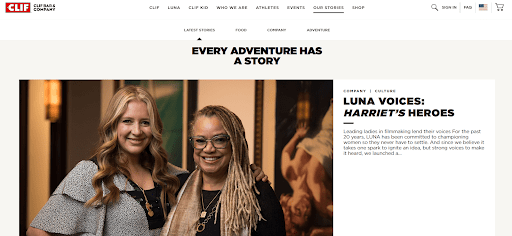
Think about the hobbies and interests of your target audience, the most frequently asked questions you get, how someone might get use out of your product, or write a series of posts on a theme, and you’ll have a great list to get cracking on.
2. Include discounts to incentivize subscribing
While some visitors will be natural devotees and want to subscribe to your emails to get product updates and company news, others will want something of value in exchange. Subscribers will sign up if they have a chance of being surprised with exclusive offers, coupons and discounts. You can offer customers a percentage or dollar amount off their next purchase. Generally, stick to whichever deal sounds larger between the two, which you could determine from average order amount.
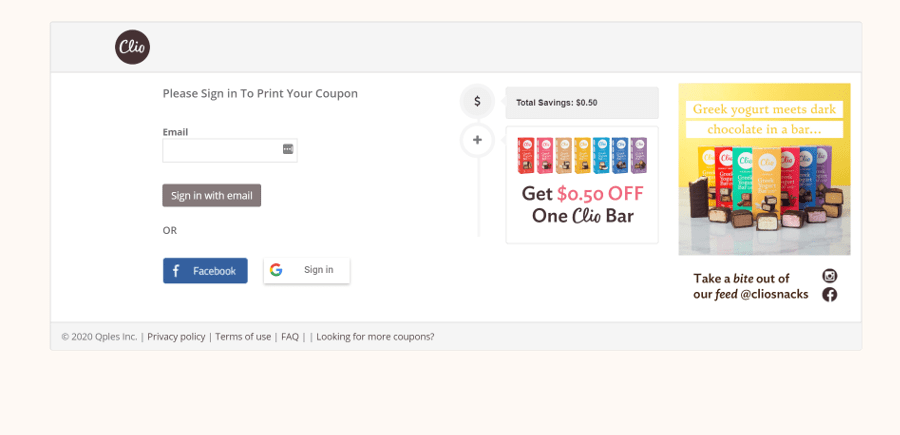
This is by far the most common incentive to capture emails. It’s tried and true but will not grab attention. One way to make it a bit different is to let subscribers know they will also receive all future promotional discounts as well, so savings are not a one-time thing.
3. Offer Free Samples to build your list
You can also offer a free sample of your product. To receive the sample, the person would need to enter contact information including email address. To defray shipping cost, you could require them pay for shipping or a portion of it while you cover the product cost.
Grab the Gold offers free samples of their products where the customer pays $0.99 for shipping. This could be especially effective if your product is not widely distributed in stores.
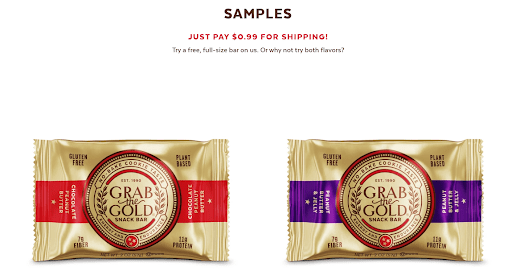
Another benefit is you receive physical addresses of customers since you need to ship to them. You could use it to send future promotions or gifts as well as use any trends in addresses to inform where new distribution or stores are needed.
4. Create a loyalty program
Loyalty programs are both beneficial to growing and retaining your business. They also are a great perk of becoming a member or email subscriber. Decide what you want to include in your loyalty program, like level of email engagement or points for purchases, and use that as a lure to get more folks signed up.
While it isn’t a food brand, the consumer brand Bath and Body Works has successfully been employing a loyalty program for years. The more often you purchase and engage with the brand, the better your perks. Think about the actions your potential and current customers could take that are valuable to you, and build those into your rewards program. To unlock the first perk, you could require an email address.
5. Sign up for free shipping
This one is straightforward and works. If someone signs up to your email list, shipping is free. If you are able to make this viable, it’s a great way to grow your email list. If you have an ROI similar to the 44x average listed at the beginning of this article, chances are, it’s worth offering free shipping. Here’s an example from Akua kelp jerky:
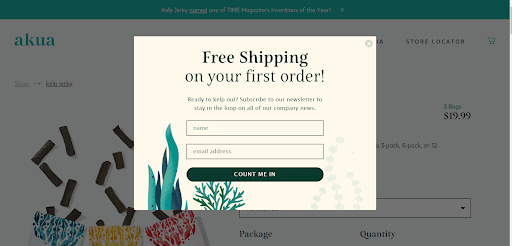
6. Create a referral program
Instead of trying to get all the email subscribers yourself, reward current subscribers and customers who introduce your email content to others. Customers will be more likely to tell others if they get free or discounted items.
Naturebox, a healthy snack subscription service, offers rewards for customers referring their friends and also has an affiliate program for anyone who wants to promote their product line more widely.
Don’t forget to include a share email link in all emails. You never know who may want to forward your emails to a friend or colleague!
7. Run a giveaway
Everyone likes getting things for free. Promoting a giveaway can be a fast and furious way to grow your email list. What you want to do is offer a package that’s enticing enough for people to sign up for multiple entries. Most giveaway tools, like Rafflecopter, allow entrants to tag others, follow social media accounts, subscribe to emails, and more to gain extra entries.
Here’s a giveaway example from Magic Spoon. They’re offering a free month of cereal to anyone who signs up, which would be tempting for anyone curious to try the cereal in the first place.
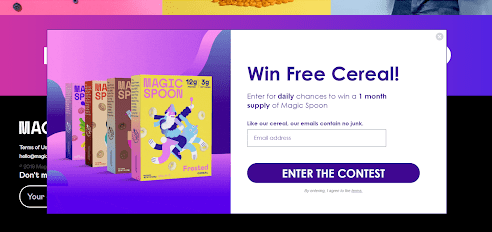
You also want to offer a package that’s specific to your target audience. This increases the likelihood that the people entering are relevant people for your email list. A lot of giveaways offer generic gifts like iPads, but instead, think about what specific products your target persona would love. For example, if you sell infused water, you could put together a package that includes a yoga mat, subscription to an online workout program, a gym bag, and essential oils. Giveaways are a great opportunity to partner with other brands that share similar audiences, so consider a co-sponsored food giveaway too.
8. Publish informative content like a free e-Cookbook
First, think about what your audience might want to learn more about in-depth. Now, create a substantial piece of content for your audience, which only requires an email in exchange. This idea isn’t limited to a cookbook. You can create any long-form content you want and the idea is the same. Here are some ideas to get started:
- Take 25 of your most popular blogs and compile them into one eBook
- Collect recipes from the community as a free download
- Publish a book with best wines to pair with your products
- Partner with a personal trainer and offer a guide of best exercises to do based on your personality type
- If you have an earth-conscious customer base, offer recycling guidelines
The point is that, just like with blogs, the sky’s the limit.
If you really want to raise the quality of the offer, you could even offer a physical cookbook and perhaps require the subscriber to cover shipping only, similar to free samples.
9. Collect emails at trade shows and events
While trade shows and conferences are currently on hold, keep this bookmarked for later. There’s no substitute for in-person interaction, especially when food is involved. Trade shows, conferences, and other networking events are great opportunities to build your email list.
If you’re exhibiting, you have many opportunities to gather emails. Offer to stay in touch via email with anyone you connect with by collecting their business card or scanning their badge. Avoid handwritten sign-up sheets as the entries can be hard to read and labor-intensive to add into your email program.
Kick it up a notch with a fun booth activity. Bring a Plinko game, wheel, or other interactive game with you, and offer attendees a chance to play for signing up.
If you’re walking the floor and able to hand out cards, print your email subscriber-only offer on them for additional reach.
Similar strategies to encourage list sign-ups also work at smaller events like meetups, farmer’s markets and tastings.
10. Include an email offer on packaging
Don’t limit yourself just to your website when attracting potential email subscribers.
This tactic bridges the gap between physical (stores) and digital (online). Of course, most food and beverage purchases still take place in physical stores.
Therefore, on your packaging include a call-to-action for email subscribers using one of the recommendations in this article. While it’s common for brands to list their website URL or social media accounts, a more effective tactic could be to give customers a specific reason to take a next step such as a loyalty program, giveaway, or downloadable content.
What some brands do is include a QR code on the package to make the process quicker. Now that QR codes can be scanned using the iPhone camera and not a separate app, people are more likely to engage with them. A cool feature of QR codes is that some packaging options can create a separate code for each package giving you details on the action taken.
11. Make an Email Sign Up button for your Facebook page
This suggestion is quick and easy so it is worth doing even if it may not yield a ton of sign-ups.
On the Facebook page for your food or beverage brand, there is a customizable button. Most brands have a standard ‘contact us’ or ‘learn more’ call-to-action and link to their homepage.
However, there is another call-to-action option called “Sign up.’ For this option, link the button to a page where people can sign up for your email newsletter directly or via an offer that requires an email. Every bit counts.
12. Run lead form ads
Both Facebook and Google have ad types where people can provide their email to learn more about a specific product or offer. Lead form ads are different from typical pay-per-click ads, where the click of an ad goes to your website. Instead, brands pay per email (lead form) that opts in.
13. Call out your newsletter in social post
Most brands never mention the fact that they have an email newsletter in their social feed. Consider sharing a link to your newsletter or offer with a social media post featuring compelling visuals and copy. If people are engaging with your social media, they may want to receive your emails. If you truly have excellent content and newsletter, make a point to call this out in a social media post every so often so people can get your wonderful content the way they want.
14. Create Coming Soon page with email form
Food and beverage brands are known for launching exciting new flavors and products.
For your next launch, consider creating a “coming soon” page for a new flavor or product line (or new company if that is the case). Simply ask for an email entry to be notified of updates on the launch.
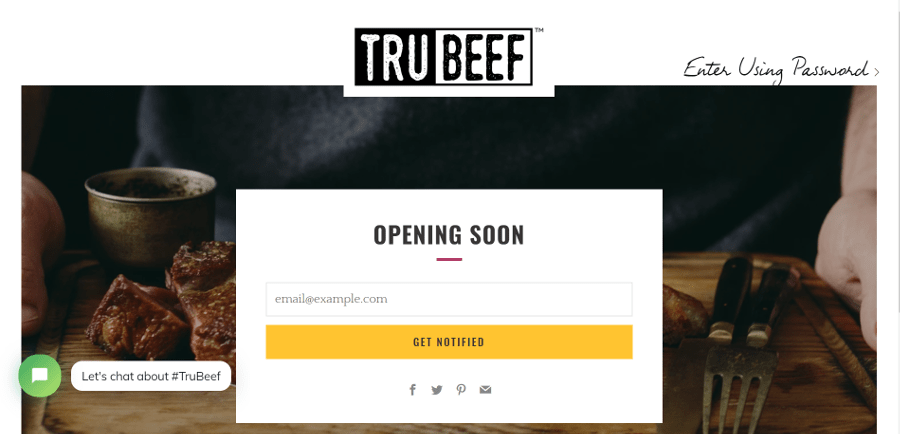
15. Tie-in social mission with email list
Many food brands are heavily invested in a social or environmental mission such as climate change, hunger, or social justice. One way to do good while building your email list is to link the two. If your mission is helping the environment, you could plant a tree for every new subscriber. If it’s relieving world hunger, you could donate a meal for each new subscriber. If you are not able to plant a tree or cook the meal yourself, you could go through a non-profit. For this, figure out the dollar amount donation that is needed for an organization to supply the tree or meal (or whatever) and donate that per each new email subscriber. For something less tangible like social justice, you could donate a certain amount of dollars per each subscriber although this feels a bit more transactional.
It’s important to really get the messaging correct with this method as you don’t want to come off as using a social mission to sell products. Instead, it should feel like a win/win.
Summary
- Ways to build your email list as a food brand include:
- Create an interesting blog so people actually want to sign up for your newsletter
- Include discounts to incentivize subscribing
- Offer Free Samples to build your list
- Create a loyalty program
- Require email sign-up for free shipping
- Create a referral program
- Run a giveaway
- Publish informative content like a free e-Cookbook
- Collect emails at trade shows and events
- Include an email offer on packaging
- Make an Email Sign Up button for your Facebook page
- Run lead form ads
- Call out your newsletter in social post
- Create Coming Soon page with email form
- Tie-in social mission with email list
What are some ways that you have or seen others build their email list?
